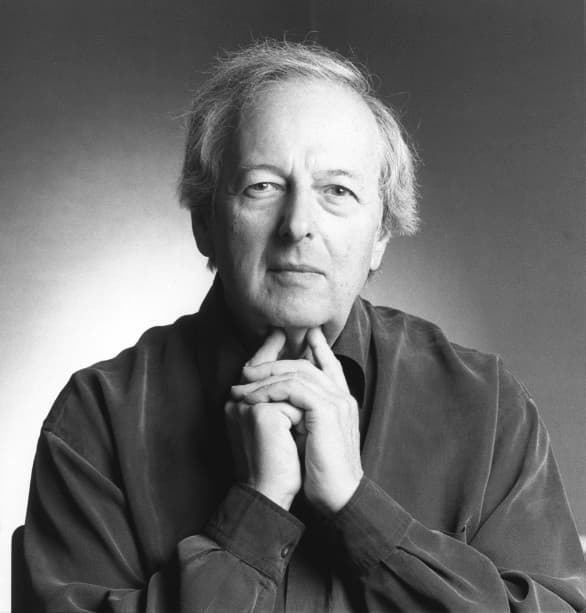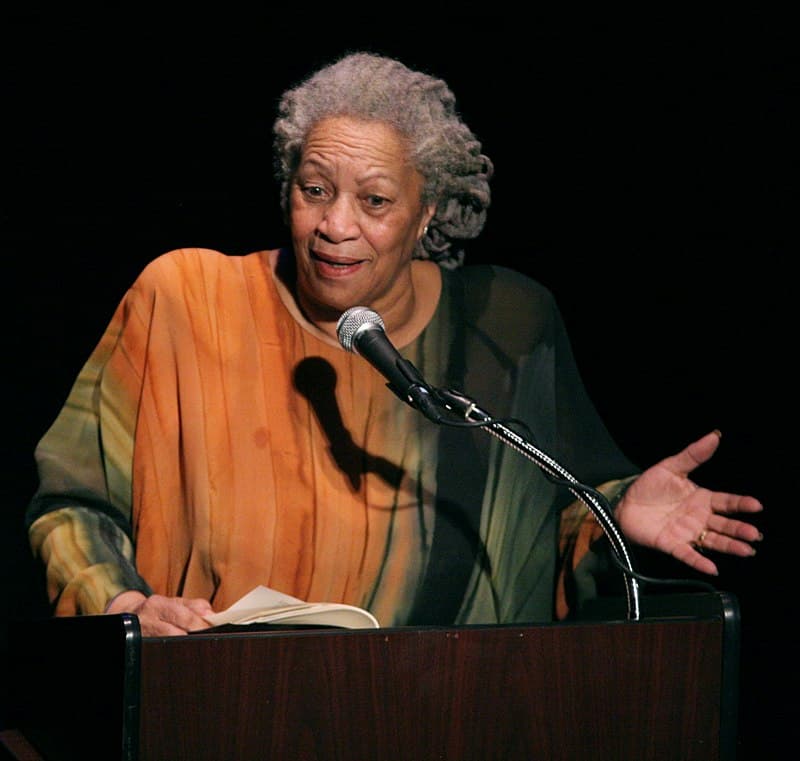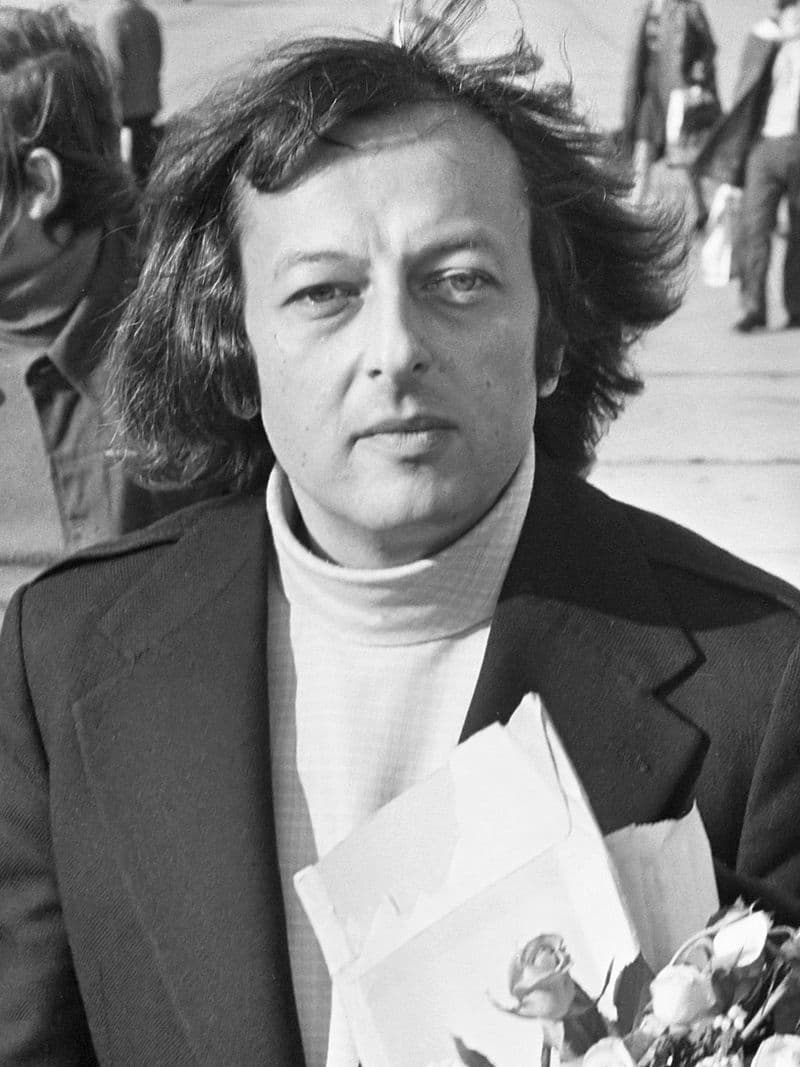Toni Morrison (1931-2019) was the first African-American woman to win the Nobel Prize in Literature. Her best-selling works explored black identity in America, and in particular the often-crushing experiences of black women. She authored 11 novels, children’s books, and a collection of essays.

Toni Morrison © James Keyser/Getty Images
A literary critic writes, “her plots are dreamlike and nonlinear, spooling backward and forward in time that rings with the cadences of black oral tradition. Her narratives mingle the voices of men, women, children, and even ghosts in layered polyphony. Myth, magic, and superstition are inextricably intertwined with everyday verities.” Her first novel The Bluest Eye was published in 1970, and it tells the story of a young African-American girl named Pecola Breedlove growing up following the Great Depression. Growing up in a white Anglo-Saxon Protestant community, Pecola is constantly reminded that she is an ugly girl due to her mannerisms and dark skin. In an attempt to beautify herself, Pecola wishes for blue eyes. Twice her father rapes her, leaving her pregnant, and her descent into insanity, “is her only way to escape the world where she cannot be beautiful and happy.”
André Previn: Vocalise
In discussing her motivations for writing The Bluest Eye, Morrison “wanted to speak on behalf of those who didn’t catch that they were beautiful right away, and to demonstrate the negative impact racism can have on one’s self-confidence and worth.”

André Previn
Toni Morrison was born Chloe Ardelia Wofford on 18 February 1931, growing up during the Great Depression in Lorain, Ohio. She grew up in a community that was a typical American melting pot, where neighborhoods were not segregated but cultural heritage was strong. Morrison’s parents instilled a “sense of heritage and language through telling traditional African-American folktales, ghost stories, and singing songs.” As Morrison later explained, “the past is just as strongly manifest in the bonds of family, community, and race; bonds that let culture, identity and a sense of belonging be transmitted from parents to children to grandchildren.” Her mother’s family included passionate amateur musicians, “who sang opera, jazz, and the blues.” Morrison became a Catholic at the age of 12 and took the baptismal name Anthony, after Anthony of Padua, which led to her nickname, Toni.
André Previn: Cello Sonata, “Vivace-Andante espressivo-Allegro” (Matthias Bartolomey, cello; Clemens Zeilinger, piano)
Morrison enrolled at Howard University in Washington D.C. to study English, and she performed with a university theatrical company that sought to raise black literary consciousness. She completed her degree work at Cornell University with a thesis on the theme of suicide in the writings of William Faulkner and Virginia Woolf. After starting a family she was hired as an editor for Random House, “playing a vital role in advancing the careers of several black women writers.” After the publication of The Bluest Eye, Morrison was considered an authority on black cultural issues and she took positions at Yale, the State University of New York, and Princeton. As Morrison explained, “Ultimately, the goal in my writing is to compose beautiful literature and to broaden the vocabulary in literature so that being a woman and being African-American are not marginalized.” Her literary aesthetic is to bear witness by retrieving and “interpreting the past in her novels by anchoring her fiction in the African-American folk tradition.” Morrison revealed her use of language and the power of words in her Nobel lecture on 7 December 1993. “The vitality of language lies in its ability to limn the actual, imagined and possible lives of its speakers, readers, and writers… Be it grand or slender, burrowing, blasting, or refusing to sanctify; whether it laughs out loud or is a cry without an alphabet, the choice word, the chosen silence, unmolested language surges toward knowledge, not destruction.”
André Previn: Cello Sonata, “Adagio” (Matthias Bartolomey, cello; Clemens Zeilinger, piano)

Toni Morrison, 2008
Morrison’s language contains images of music throughout, as her characters sing to the rhythm of the sound “that have the ability to express the depths of black music, spirituals, and jazz.” In 1991 the song cycle Honey and Rue was commissioned by the Carnegie Hall Corporation in New York City as part of its centennial celebration. Specially written for soprano Kathleen Battle, that commission paired composer André Previn and writer Toni Morrison. In fact, Morrison’s collaboration with Previn was her first attempt at writing lyrics for art songs. Morrison strongly believed that “words don’t have to make their own music. The composer will create that.” Working with images rather than a story, Morrison believes that it was beneficial that she herself was not a musician. She writes, “If I were more deeply an amateur musician myself, the lyrics might not have been that strong or that suggestive. I wasn’t overwhelmed by the concept of music. I was interested in the marriage of language and music.”
André Previn: Cello Sonata, “Allegretto” (Matthias Bartolomey, cello; Clemens Zeilinger, piano)
Honey and Rue received mixed reviews, with critics agreeing that Battle’s singing was spectacular, and there was general admiration of Morrison’s lyrics. However, Previn’s music did not enthuse everybody. Previn and Morrison followed up two years later with Four Songs for Soprano, Cello, and Piano. Originally, Morrison sent Previn five texts, but he decided not to set the last one. It contained an offensive word with Previn stating, “I don’t know what note goes with that.” There is no direct connection between the texts in Four Songs, and the speaker is female but not necessarily African-American. The piece premiered with pianist Martin Katz, cellist Carter Brey, and singer Sylvia McNair at Alice Tully Hall in New York City in 1994. Martin Katz identified and provided a summary of Previn’s musical style, and he believes that the composer uses “a drifting atmosphere, achieved by piano arpeggiation, a lack of formal repetition of sections, and shifting tonalities in his slow songs, while the fast songs are derivative of Previn’s superb jazz playing.
André Previn: Honey and Rue (Kathleen Battle, soprano; Orchestra of St. Luke’s; André Previn, cond.)

André Previn, 1973
Mercy
I could watch
Heads
Turn from the traveler’s look
The camera’s probe
Bear the purity of their
Shame
Hear mute desolation in syllables
Ancient as
Death.
I could do these things
If
Only if only
I knew that when milk
Spills
And hearts stop
Underheel
Some small thing gone
Chill
Is right
To warm toward a touch because
Mercy
Lies in wait
Like a shore.
Mercy
Mercy
Mercy
Like a shore.
Morrison explained that African-American identity has little or nothing to do with the speaker in Four Songs. “Mercy is about how the media looks at starvation, blood and misfortune in settings such as Ethiopia.” The traveler and the probing camera attempt to exploit those who can only turn away in shame. “The speaker could bear the purity of their shame, the shame of dying, if she knew that ultimately there would be mercy for them.” In his piano accompaniment, Previn supplies a steady metronomic pulse that highlights the voice and cello. The technically demanding cello part features highly chromatic lines and double stops. Essentially, the relationship between the cello and the voice is one of dialogue, and the performers only join forces during the most climactic moments.
André Previn: 4 Songs, “Mercy” (Sylvia McNair, soprano; Yo-Yo Ma, cello; André Previn, piano)
Stones
I don’t need no man
Telling me I ain’t one.
My trigger finger strong
As his on a shot gun.
Buttercake and roses smooth
Stones in my bed.
Handmade quilts cover
Stones in my bed.
I don’t need no man
Telling me I ain’t one.
My backbone ain’t like his
But least I got one.
High-heeled slippers break
Stones in my bed.
Games played at night trick
Stones in my bed.
Stones.
I don’t need no man
Telling me.
The poetry for “Stones” is based on the old blues song Rocks in my bed, and inspired by the singing style of blues singer Bessie Smith. The speaker is a determined and bold woman who is angry at the absence of a man in her life. Her lament is not one of complaint, but one of anger. “Her trigger finger, butter cake, roses, and handmade quilts are intended to make up for the lack of a man.” Relying on his jazz influences, Previn accentuates the rhythmic aspect of the song while creating an interesting color with his broad use of chromaticism. Full of syncopation and triplet figures, a soloistic piano part is assigned to an active bass line accompaniment “as one would expect in a jazz trio.” Setting the words comes very naturally to Previn as he explores the ideas with the colour and rhythm of the words.” As a critic writes, “Previn doesn’t fight the words, he doesn’t succumb to those irritating vocal tics so beloved of the contemporary music establishment.”
André Previn: 4 Songs, “Stones” (Sylvia McNair, soprano; Yo-Yo Ma, cello; André Previn, piano)
Shelter
In this soft place
Under your wings
I will find shelter
From ordinary things.
Here are the mountains
I want to scale
Amazon rivers
I’m dying to sail.
Here the eyes of the forest
I can hold in a stare
And smile at the movement
Of Medusa’s green hair.
In this soft place
Under your wings
I will find shelter
From ordinary things.
With “Shelter” the tone is wholesome and familiar, and a beautifully sustained melody represents the sentiments of the lyrics. Morrison explained that this “poem is about a woman who is having a good time in her imagination. She thinks about her man and all the challenges, both mythical and metaphorical, that she can overcome with him in her life.” Previn provides a sparse piano accompaniment that harmonically supports the vocal like. Keeping with the strophic design, Previn also incorporates humming in this song, turning this particular section into a Vocalise. Previn is not a great friend of text painting, however on “Medusa’s green hair” the line descends chromatically by half step, and the effect is echoed in the cello and the piano. According to one commentator, “this effect is representative of the deflation of mythical Medusa and all of the other challenges that the speaker encounters.”
André Previn: 4 Songs, “Shelter” (Sylvia McNair, soprano; Yo-Yo Ma, cello; André Previn, piano)
The Lacemaker
I am as you see
What most becomes me:
Miles skipped
Cancelled trips
Masters yet unmet.
Lace alone is loyal, sacred, royal, in control
Of crimes stopped
By patterns of blood bred to best behavior.
As you see I am
What has become of me.
For Morrison, the character in “The Lacemaker is hollow, regretful and mournful. The lyrics are an assessment of a woman who has settled for less in life. Her vocation as a lacemaker has prevented her from committing “crimes” in her life, passions that she’s left unexplored. In lieu of trips and personal adventures, she has chosen to become a woman who creates lace for royalty.” Previn’s setting, although it appears simple at first glance, is dramatic and extremely effective. The musical interest seems to be taken by the cello and piano, with brief vocal outbursts that are interrupted by instrumental commentary. Even though she is empowered through song, the speaker remains insignificant and lackluster throughout. In this concluding song, Previn appears to pay particular attention to the dramatic intent of Morrison’s lyrics, “as the music conveys intense sadness and disappointment in every respect.” A critic writes, “The so-called art song is gathering vitality now that poets such as Nobel Prize Winner Toni Morrison are involved, inspiring the inclusion of jazz and blues in pop/classical hybrids.” Previn’s music settings were generally well received. “But if his conducting career remains somewhat lackluster, Previn’s own music is beginning to look special… The Four Songs are beautifully made, the powerful expression of a complete musical personality. And the performances are riveting as if it had suddenly dawned on the players that Previn has crossed a threshold as a composer.”
For more of the best in classical music, sign up to our E-Newsletter
André Previn: 4 Songs, “The Lacemaker” (Sylvia McNair, soprano; Yo-Yo Ma, cello; André Previn, piano)
